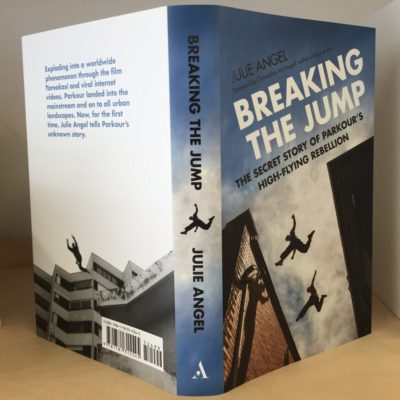 I’m not sure exactly when I discovered parkour. Its first mention here in my blog is in May 2014 when I talk about starting to practice precisions and shoulder rolls.
I’m not sure exactly when I discovered parkour. Its first mention here in my blog is in May 2014 when I talk about starting to practice precisions and shoulder rolls.
By then, Julie Angel had already finished a PhD and created a large body of photos and videos on parkour.
I came across her work fairly early, and immediately appreciated its strength, so I was delighted to learn that she was writing a book. I bought a copy as soon as it came out, and spent last week reading it.
I’d read some about the early history of parkour, so I knew about David Belle as an individual and the Yamakasi as a group, but this was largely my first exposure to the other early practitioners as individuals—and a bunch of interesting individuals they are.
Early in the book Angel takes a stab at tweezing out the many threads that went into making parkour something that appeared in this place at this time: The urban planning that produced the built infrastructure in Lisses and that also drew in the immigrant population that lived there. The life- and family- histories of the handful of young men who became the Yamakasi. The kinds of men they were. Angel never really pins down exactly why these young men produced parkour when no one else had done so, but it’s a credible effort at answering a question that’s probably unanswerable.
Because on the one hand, many other groups of young men could have created parkour. Most of the key traits of these young men—a certain facility with movement; a willingness to train very, very hard; a tendency to push one another to ever greater efforts (and to let themselves be pushed)—are not that rare. Although many young men are clumsy or lazy, you need only look among the national-level competitors in any boys or junior individual sport, or even at any good high school sports team, to find both movement skill and the capacity for hard training.
More important than those things—which are, as I say, fairly common among young men—was an ethos that leaned against that willingness to push and be pushed. It’s an ethos exemplified in some of their sayings—things like “Start together, finish together,” and “Be strong to be useful.” Everyone was pushed outside their comfort zone, but no one was pushed to attempt anything that he didn’t know he could succeed at. It is surely the reason that early parkour practitioners had such an incredibly low rate of training injuries whether from accidents or from overtraining. (Would that runners were as durable.)
New to me—and a perfect example of that ethos—is the picture Julie Angel gradually paints of Williams Belle. Younger than the others, he was someone I hadn’t even been aware of until I read the book. Williams is portrayed as having all the movement skill and all the willingness to train very, very hard as any of the other pioneers, but lacking the ego of David Belle, and possessing teaching methods that seem uniquely gentle.
She has Stéphane Vigroux saying this about Williams:
On the surface it was the same training school, but somehow the energy and feel when observing Williams was different. . . . From the first jump . . . Williams had known that the discipline should be about helping and sharing with others.
It makes Williams sound like someone I’d like to get to know.
Angel includes a good look at the prehistory of parkour—Georges Hébert and others—and a look at contemporaries who created things that overlap—people like Erwan Le Corre—but it’s not really about them. Most of the book is about the early practitioners. But only most of the book. A little bit—maybe ten or fifteen percent—is kind of a memoir of Julie Angel’s own experiences beginning with parkour. Her stories of her struggles to break her own jumps, learn to balance on a rail, or simply to attend her first class are very effective at illuminating the journey of the founders.
Maybe she used every such story she had—at least, that’s the only good reason I can think of for including so few, because frankly, those bits are some of the best bits in the book. If she wrote a longer memoir of her own journey learning parkour, I’d buy it.
If you’re interested in the history of parkour, and especially if you’re interested in understanding what it meant to those early folks—what it meant to work together, to train very hard, to confront their fears and overcome them together—this is an outstanding book
Breaking the Jump: The secret story of parkour’s high-flying rebellion by Julie Angel.

Hi Philip, glad you enjoyed the book and to answer your question, yes there are a 100 more of my own Parkour stories I could tell :).
I hope I get to hear or read some!